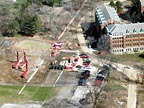One of the benefits of going to tradeshows is the opportunity to catch up with friends and colleagues, to swap tales and talk business. Earlier this year, in conjunction with the Michigan Ground Water Association's (MGWA) annual convention, National Driller once again met with a group of contractors to discuss their perspectives on what's taking place in the industry. Their reflections on what they've seen and experienced during the last year or so will no doubt resonate with contractors across the country. Issues such as finding and retaining good employees, meeting rising insurance costs, coping with material storages and battling different pricing structures all surfaced - subjects that concern drilling contractors on a daily basis.
The morning's discussion begins over a continental breakfast. Joining this year's roundtable: Stan Brown, Brown Drilling Co., Howell, Mich.; Steve Buer, Buer Water Well Drilling, Caledonia, Mich.; Bill Pearson, Pearson Drilling Co., Lake City, Mich.; and Steve Wheeler, Ann Arbor Well Drilling Inc., Dexter, Mich.
Establishing their reputations, MGWA executive director John Schmitt introduces the contractors and vouches for the quality of their work. “They're all good guys. I wouldn't mind having any one of these guys put a well down my yard,” confides Schmitt, who arranged for the contractors to participate in the roundtable discussion.
Introductions accomplished, the conversation gets underway.

Steep Insurance Costs
The rising cost of health care in this country is a big discussion point. Retaining good employees is difficult enough for drilling contractors, and in many areas, impossible unless good benefits are offered. But contractors who provide health insurance are carrying an increasingly heavy financial burden. And it isn't careless employees with outrageous work comp claims that are driving up the costs; prices simply are escalating. Being able to provide health-care packages in both the short- and long-term is a huge concern for these contractors.“The big issue I have that I don't go through a day without thinking about it is the health-care issue,” Brown reveals. “We're over $100,000 a year. It's just ridiculous. It goes anywhere from an 18 percent increase, a 12 percent increase, a 20 percent increase. In our area, we can't tack that onto the well - it doesn't work that way. That's our biggest issue, paying for their health care.”
As Pearson describes, contractors who have healthy employees may fare somewhat better than their counterparts who don't: “We were fortunate. We went to a private carrier this year because we had a healthy group, but the rates are just climbing out of sight. If we get somebody who doesn't fit the mold, then we're going to have to backtrack. But right now, we save the pennies we're saving.”
One way contractors can combat rising insurance costs is to split a portion of the expense with employees. “Last year was the first year we went to the guys and said we're going to have to do something here, because we've been paying the whole thing,” Buer explains. “We elected to raise the deductibles a little bit; that was the only way we could hold the cost.” However, as Brown points out, increasing deductibles may only be a temporary fix: “You run out of ways to make up for it. We've cut every corner. With large deductibles, we're asking them to pay a little more; I think it's 18 percent or 22 percent they pay now. Eventually you run out of ways.”
Unfortunately, these contractors don't anticipate the situation improving any time soon. “I sit on the board of directors for an engineering company,” Pearson recounts, “and two years ago, the CEO projected health insurance costs. Basically, within 10 years, if the increases stay the same, health insurance would be a larger expense than payroll.”
Yet providing health care remains a necessary evil. “We couldn't even compete in our area if we didn't have health insurance,” Brown says. “We wouldn't have anybody. There'd be nobody there.”

Help Wanted
This year, the four roundtable contractors are in positions to either maintain the staff they already have or expand their outfits. With expansion comes hiring, however, and as most contractors would agree, good help can be hard to find. What's more, recruiting young workers may prove to be a long-term issue for the industry.“Most of my employees are 34 and older,” Brown reveals. “I think I've got one who's younger. My father had a group of guys who all stood with him for 20 years or longer. They're all retired and we've got a fresh batch starting out, but no kids from the high school - unbelievable, not a one. Our office is 2 miles from a high school. There hasn't been one kid that's stopped and asked for a summer job in 12 years, 15 years - not even a mow-the-yard person.”
“Well drillers traditionally found their best employees in farm kids - they know how to work,” Buer explains. “It is a bit of a shock for some kids. As we get more and more urban, kids have no clue; that kind of life is unacceptable - the long hours and some weekends, some mud and cold. It improved a little bit last year, but it's going to have to get pretty tough before the kids are ready to just flat out work. That might be an industry problem in the future.”
Geography also can affect the hiring pool. In rural areas, there are less people to hire, but also fewer places that are hiring. In more populous parts, while there are more potential employees, there's also greater competition among companies looking to hire, and job seekers can afford to be more selective. Describing how the local population impacts his hiring practices, Brown recounts: “In our area, there are more people, but we've also got to compete with all the factories. I've lost more employees to Ford Motor Co. - some of the best employees. I can't blame them sometimes with the benefits.”
Discussing family involvement in their businesses, the contractors report that many family members have done some drilling work, often testing the waters, but many of them are choosing to pursue other careers. “My brother actually just graduated from high school. He's been in the business and we're going to kind of see how it goes. He's worked for us for the last two or three summers. He's trying it out, I guess,” notes Wheeler, with some of the other participants echoing similar situations.
“My oldest son worked for us,” Buer remarks. “He was a good worker and worked hard, so he understood it. But I think he evaluated it and said there's easier ways, so he moved on. And I can't actually blame him, you know. It's not an easy way to make a living. It really isn't.”

Painful Steel Shortage
The drilling industry stands to be hard hit by the current steel shortage, according to what these contractors have seen and expect for the near future.“With the increases, we've bought a lot more supplies and are stockpiling,” Pearson describes. “Our barns are full. One of the cable tool drillers up north who's strictly cable tool actually bought a truckload of pipe. He's nervous. So he could stay in business, he ordered at the old price and it was available to him. They are quite nervous and rightly so right now.”
Brown too is stockpiling steel supplies: “We stock large casing up to 16 inches. Once it's gone, we'll be paying I think it's 40 percent more - I didn't really figure the numbers. It's going to be a tremendous increase. Hopefully, that's short term.”
Prices not only for items like tanks and screens, but also for large pieces of equipment are going to be impacted. “It's going to be everything,” Buer explains. “We're buying a service body and they said hurry up and order it because the steel prices are going to go up so high we've got to keep changing the prices.”
And changing they are. Prices are good only for 30 days, and in some cases, the cost of steel-made products changes weekly. Ever resourceful, however, some of the contractors - acknowledging prices are climbing painfully high - also see the shortage as an opportunity. “I think that we and one other company I know of are going to have to increase our prices,” Brown reveals. “We've already started to do that here a couple weeks ago. Hopefully, everybody can use it to raise the prices.”

Disparate Pricing Structures
One thing gleaned from the roundtable discussion is that pricing matters - and matters significantly. The general consensus is that as an industry, drilling contractors charge too little for their services.“On a new construction housewell, prices are dirt-cheap; people are getting a heck of a deal,” says Brown, describing why contractors should be charging more. “On a new construction job, who else is going to come onto the site with a half million dollars worth of equipment other than the well driller? Most of them just bring a pickup. The capital investment the well driller's got when he goes onto a new homesite, there's nobody who's going to match it. It's not just the drilling machine and the support truck - it's also the backhoe, the trailer, the truck to pull it.”
“Doesn't that seem to be the biggest flaw with our industry?” Buer asks. “As an industry, we don't charge enough. It makes things really difficult. Well drillers don't want to work in any kind of cohesive way, like plumbers, where there are kind of standard rates. We just don't make enough money for all we're trying to do. I see some of the stuff that comes across, guys quoting wells still for under $3,000. Come on, that's ridiculous. Then the legitimate businesses are paying insurance, trying to go by the rules - that's a tough road to hoe. That's the toughest thing we have, especially as these other costs are sky-rocketing.
“In our area, we're in the top on prices,” Buer reveals. “Everybody else enjoys coming in under it. If a guy comes in $200 under, that's one thing. But to get beat by $1,000 on a 100-foot well, something's going on. I had one the other day that was $1,200. It just boggles my mind.”
“That's why you hear everybody at the show talking about not making any money,” Wheeler asserts. “Anybody asks, the first thing they'll say is they're not making any money. It's their own fault.”
When asked why some contractors won't raise prices even when other companies are charging more, Buer replies: “The thing I hear from the other contractors is 'Well, I can't do that in my area.' That's what you'll hear every time. I understand how it is: You've got the equipment, you need to work. I was hopeful that with all these increases and costs, maybe some of these guys will do their five-year review of what they're paying for stuff. Maybe they'll come up a bit.”
However, according to Brown, it would take more than a simple price adjustment to rectify this industry-wide issue. “Not all companies know what their bottom line is and what it costs to operate,” he explains. “I think a lot of them need business management lessons - a seminar on how to figure out what the actual cost is.”

Potential Markets
Trying to anticipate the next big market can be tricky. An abundance of work in one market can quickly diminish just a few years later. At the moment, the environmental market is not as lucrative as it once might have been.“There's not a lot of [environmental] work out there, and one of the things that's a negative is your employees have to go through another step of training, like 40-hour hazardous waste training to qualify for that work,” Pearson reveals. “Our people have been through that and it's just another expense to maintain. Once you've been through that, it's an eight-hour refresher, so we've combined with our other safety training and that works out well. But there just isn't that much environmental work out there.”
In contrast, the indications are that geothermal is a growing market for those looking to expand and perhaps willing to work farther afield. With the change in the cost of natural gas, it now appears that more and more of these projects are available.
“Geothermal seems to be the increase area; you just have to figure out how to make money doing it,” Buer notes. “That seems to be where I see there's a lot of work to be done.”
When asked what caused sudden growth, Pearson informs: “Over a several-year period, they've made some great advances in the geothermal - going to a closed-loop system, so if they're running anti-freeze or that type of chemical where they can increase efficiencies because they can get a bigger swing in the temperature changes. There's technical advantages there. A lot of the old geothermals, you'd put a well in and run the well water through and out to a pond or out to a river, and away it went. We've put some bids out on some geothermal wells in a larger geographic area. We don't know where that'll go. We'll see if that works.”
ND
Report Abusive Comment